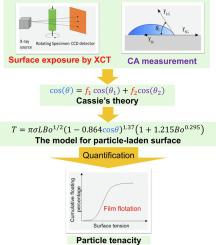Minerals Engineering ( IF 4.9 ) Pub Date : 2023-05-22 , DOI: 10.1016/j.mineng.2023.108139 Xiaozhen Ma , Ngoc N. Nguyen , Anh V. Nguyen , Jan D. Miller

|
Determination of mineral floatability versus mineral surface exposure and hydrophobicity has been challenging because of significant deviations of flotation model assumptions for real mineral surfaces and the unavailability of suitable research tools. Here, we report a successful application of combined advanced experimental techniques and modeling to determine mineral floatability versus mineral surface exposure and hydrophobicity. Specifically, high-resolution X-ray microcomputed tomography (HRXMT) was used to determine the surface exposure of composite mineral particles of quartz and chalcopyrite and compared it with the mineral floatability obtained by film flotation experiments and the contact angle (CA) of the mineral particles. The surface exposure was obtained from the HRXMT images using in-house software. Cassie's theory was applied to estimate the CA of composite particles from the CAs on single mineral phases. The mineral floatability was described by extending the new theory on max adhesion force (tenacity) that holds the particles attached to the bubble surface. The comparison shows a good agreement between the tenacity, surface tension, and the CA calculated from the surface exposure data together with the CA on single mineral phases. This is the first work that quantifies the effect of surface exposure on the floatability of composite particles and can be applied to predict the flotation performance of the composite particles in the mineral processing industry.
中文翻译:

通过高分辨率 X 射线显微计算机断层扫描、薄膜浮选、接触角和建模研究矿物可浮性与矿物表面暴露和疏水性
确定矿物可浮性与矿物表面暴露和疏水性一直具有挑战性,因为真实矿物表面的浮选模型假设存在重大偏差,并且没有合适的研究工具。在这里,我们报告了一项成功的应用,结合先进的实验技术和建模来确定矿物可浮性与矿物表面暴露和疏水性。具体而言,使用高分辨率 X 射线显微计算机断层扫描 (HRXMT) 确定石英和黄铜矿复合矿物颗粒的表面暴露,并将其与薄膜浮选实验获得的矿物可浮性以及矿物的接触角 (CA) 进行比较粒子。使用内部软件从 HRXMT 图像获得表面曝光。卡西' 应用 s 理论来估计来自单个矿物相上 CA 的复合颗粒的 CA。矿物可浮性是通过扩展关于使颗粒附着在气泡表面的最大粘附力(韧性)的新理论来描述的。比较表明,根据表面暴露数据计算的韧度、表面张力和 CA 与单一矿物相的 CA 之间具有良好的一致性。这是第一项量化表面暴露对复合颗粒可浮性影响的工作,可用于预测选矿工业中复合颗粒的浮选性能。矿物可浮性是通过扩展关于使颗粒附着在气泡表面的最大粘附力(韧性)的新理论来描述的。比较表明,根据表面暴露数据计算的韧度、表面张力和 CA 与单一矿物相的 CA 之间具有良好的一致性。这是第一项量化表面暴露对复合颗粒可浮性影响的工作,可用于预测选矿工业中复合颗粒的浮选性能。矿物可浮性是通过扩展关于使颗粒附着在气泡表面的最大粘附力(韧性)的新理论来描述的。比较表明,根据表面暴露数据计算的韧度、表面张力和 CA 与单一矿物相的 CA 之间具有良好的一致性。这是第一项量化表面暴露对复合颗粒可浮性影响的工作,可用于预测选矿工业中复合颗粒的浮选性能。











































 京公网安备 11010802027423号
京公网安备 11010802027423号